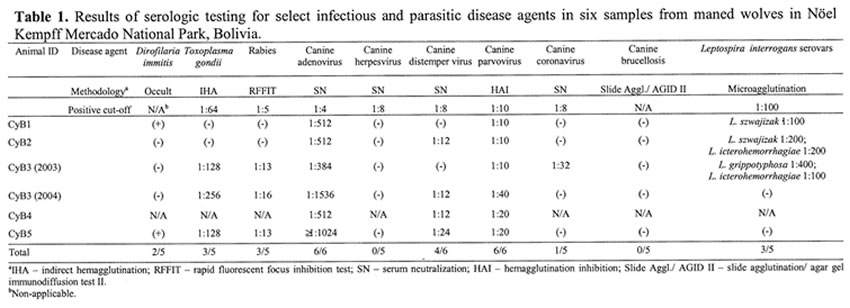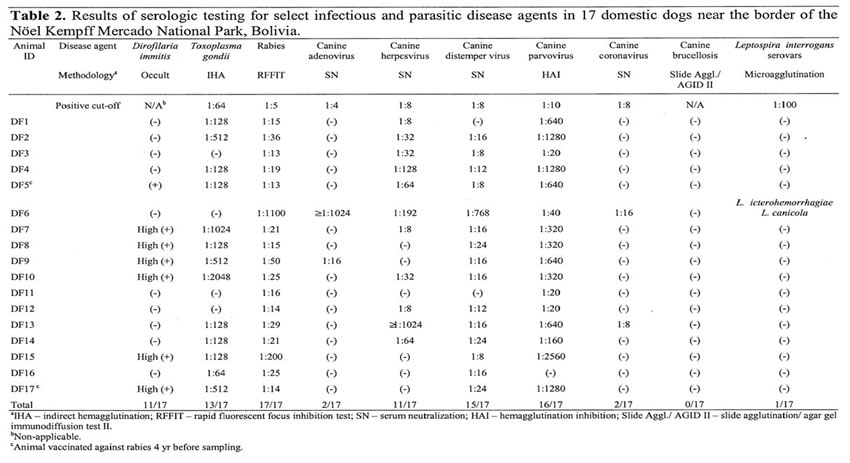Abstract
The threat of disease transmission from domestic animals to wildlife has become an increasing concern in recent years.3 Domestic dogs pose a significant risk as reservoirs of infectious diseases for wildlife4 and have been implicated in epidemics in African lions (Panthera leo),7 Ethiopian wolves (Canis simensis),6 and African wild dogs (Lycaon pictus)1,5. The objective of this study was to determine the prevalence of exposure to select infectious and parasitic agents of maned wolves (Chrysocyon brachyurus) within the Nöel Kempff Mercado National Park, Bolivia (NKMNP) and the domestic dogs surrounding the park and is part of a larger study examining the ecology, genetics, and health of the maned wolves within NKMNP.2 Five maned wolves were sampled during six anesthetic events within NKMNP from 2000–2004. Blood from 17 adult domestic dogs from a village bordering the park were also sampled. Results are presented in Tables 1 and 2. There was evidence of exposure in the maned wolves to many common canid pathogens, most notably canine distemper virus, canine parvovirus, canine adenovirus, and Dirofilaria immitis. A high percentage of the domestic dogs tested also had evidence of exposure to many of these same pathogens. The results of this survey provide evidence of exposure to multiple common infectious agents in the domestic dog populations around the NKMNP and in the maned wolf population within the park.


Literature Cited
1. Alexander, K.A., and M.J. Appel. 1994. African wild dogs endangered by a canine distemper epizootic among domestic dogs near the Masai Mara National Reserve, Kenya. J. Wildl. Dis. 30:481–485.
2. Deem, S.L., and L.H. Emmons. 2005. First reported evidence of exposure to infectious and parasitic disease agents in free-ranging maned wolves (Chrysocyon brachyurus) in the Nöel Kempff Mercado National Park, Bolivia. (In press).
3. Deem, S.L., W.B. Karesh, and W. Weisman. 2001. Putting theory to practice: wildlife health in conservation. Conserv. Biol. 15:1224–1233.
4. Fiorello, C.V., S.L. Deem, M.W. Gompper, and E.J. Dubovi. 2004. Seroprevalence of pathogens in domestic carnivores on the border of Madidi National Park, Bolivia. Anim. Conserv. 7:45–54.
5. Gascoyne, S.C., M.K. Laurenson, S. Lelo, and M. Borner. 1993. Rabies in African wild dogs (Lycaon pictus) in the Serengeti region, Tanzania. J. Wildl. Dis. 29:396–402.
6. Laurenson, K., C. Sillero-Zubiri, H. Thompson, H.F. Shirferaw, S. Thirgood, and J. Malcolm. 1998. Disease as a threat to endangered species: Ethiopian wolves, domestic dogs and canine pathogens. Anim. Conserv. 1:273–280.
7. Roelke-Parker, M.E., L. Munson, C. Packer, R. Kock, S. Cleaveland, M. Carpenter, S.J. O’Brien, A. Pospischil, R. Hofmann-Lehmann, H. Lutz, G.L.M. Mwamengele, M.N. Mgasa, G.A. Machange, B.A. Summers, and M.J.G. Appel. 1996. A canine distemper virus epidemic in Serengeti lions. Nature. 379:441–445.